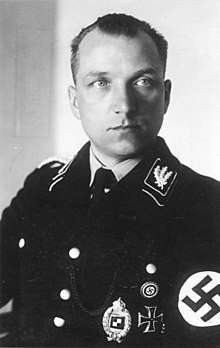SS Main Office
The SS Main Office (German: SS-Hauptamt; SS-HA) was the central command office of the Schutzstaffel (SS) in Nazi Germany until 1940.
| SS-Hauptamt (SS-HA) | |
 Vehicle command flag for SS Main Office | |
SS logo | |
| Agency overview | |
|---|---|
| Formed | 30 January 1935 |
| Preceding agencies |
|
| Dissolved | 8 May 1945 |
| Jurisdiction | Occupied Europe |
| Headquarters | Prinz-Albrecht-Straße, Berlin |
| Minister responsible |
|
| Agency executive |
|
| Parent agency | |
| Child agencies | |
Formation
The office traces its origins to 1931 when the SS created the SS-Amt to serve as an SS Headquarters staff overseeing the various units of the Allgemeine-SS (General SS). In 1933, after the Nazi Party came to power, the SS-Amt was renamed the SS-Oberführerbereichen and placed in command of all SS units within Nazi Germany. This agency then became the SS-HA on January 30, 1935.[1] The organization oversaw the Allgemeine-SS, concentration camps, the SS-Verfügungstruppe (Special-purpose troops), and the Grenzschutz (Border Control regiments).[1]
During the late 1930s, the power of the SS-HA continued to grow becoming the largest and most powerful office of the SS, managing nearly all aspects of the paramilitary organization. This included the SS officer schools (SS-Junker Schools), physical training, communication, SS garrisons, logistics and support.[1] Shortly after the outbreak of World War II in Europe, the SS-Verfügungstruppe expanded rapidly becoming the Waffen-SS in 1940. By this time, the office of the SS-Hauptamt could no longer administer the entire SS organization. As a result, the SS-HA was downsized losing much of its pre-war power to the SS Führungshauptamt (SS Leading Main Office; SS-FHA) and the main offices of the Allgemeine-SS, such as the Reich Main Security Office.[2]
Recruiting members for the Waffen-SS was handled through the SS-HA and its chief, Berger. This caused overlapping jurisdiction and friction with the SS-FHA.[3] Berger's SS-HA had a problematic relationship with the SS-FHA, which was responsible for organising, training and equipping the Waffen-SS. The SS-FHA wanted the Waffen-SS to be a small elite corps, but Berger and Himmler knew that Adolf Hitler needed as many divisions as possible, even if that meant some Waffen-SS formations would be of lesser quality.[4] During the early war years, to meet the high casualty rates and expansion of Waffen-SS field divisions, members of the Allgemeine SS were used for compulsory recruitment drives by the SS-HA for both the Waffen-SS and the SS-Totenkopfverbände. The General SS members were especially seen as well suited for duty at the Nazi concentration camps and extermination camps.[5] From 1942, forward, other personnel working for SS organisations were also drafted into the Waffen-SS to meet its manpower needs.[5]
Organization
In 1940 the SS-Hauptamt remained responsible for SS administrative matters such as manpower allocation, supplies, personnel transfers, and promotions. The SS-HA had 11 departments (Ämter or Amtsgruppe):[6]
- Amt Zentralamt (Central office)
- Amt Leitender Ärzt beim Chef SS-HA (Chief Medical Officer)
- Amt Verwaltung (Administration)
- Amt Ergänzungsamt der Waffen-SS (Waffen-SS Reinforcements)
- Amt Erfassungsamt (Requisitioning)
- Amt für Weltanschauliche Erziehung (Ideological Training)
- Amt für Leibeserziehhung (Physical Training)
- Amt für Berufserziehung (Trade Training)
- Amt Germanische Leitstelle (Germanic Control)
- Amt Germanische Ergänzung (Germanic Recruitment)
- Amt Germanische Erziehung (Germanic Education)
The SS-HA was technically subordinate to the Personal Staff Reichsführer-SS, but in reality it remained autonomous.
Leadership
| No. | Name | Took office | Left office | Time in office | Ref | |
|---|---|---|---|---|---|---|
| 1 | SS-Gruppenführer Curt Wittje (1894–1947) | 12 February 1934 | 14 May 1935 | 1 year, 91 days | [7] | |
| 2 | SS-Obergruppenführer August Heissmeyer (1897–1979) | 14 May 1935 | 9 November 1939 | 4 years, 179 days | [7] | |
| 3 | SS-Obergruppenführer Gottlob Berger (1896–1975) | 1 December 1939 | 8 May 1945 | 5 years, 180 days | [7] |
Post-war

After the end of World War II in Europe, members of the SS-HA were charged with war crimes and crimes against humanity. Gottlob Berger, its former chief was arrested in May 1945 and tried in 1949. The trial against Berger and his co-defendants commenced on 6 January 1948,[8] and ended on 13 April 1949.[9] Berger was sentenced to 25 years imprisonment, but received credit for the four years during which he had been in custody awaiting trial.[10] Berger was released from Landsberg prison in 1951.[11]
References
Citations
- Yerger 1997, p. 13.
- McNab 2009, pp. 36, 41.
- Wegner 1990, pp. 296–298.
- Weale 2010, pp. 118–119.
- Wegner 1990, p. 306.
- Yerger 1997, pp. 14–15.
- Yerger 1997, p. 15.
- Heller 2011, p. 79.
- Heller 2011, p. 103.
- NMT 1949, p. 867.
- Maguire 2013, p. 206.
Bibliography
- Heller, Kevin Jon (2011). The Nuremberg Military Tribunals and the Origins of International Criminal Law. Oxford, New York: Oxford University Press. ISBN 978-0-19-162212-0.CS1 maint: ref=harv (link)
- Maguire, Peter H. (2013). Law and War: International Law and American History, Revised Edition. New York, New York: Columbia University Press. ISBN 978-0-231-51819-2.CS1 maint: ref=harv (link)
- McNab, Chris (2009). The SS: 1923–1945. Amber Books Ltd. ISBN 978-1-906626-49-5.CS1 maint: ref=harv (link)
- Weale, Adrian (2010). The SS: A New History. Little, Brown. ISBN 978-1-4087-0304-5.CS1 maint: ref=harv (link)
- Wegner, Bernd (1990). The Waffen-SS: Organization, Ideology and Function. Blackwell. ISBN 0-631-14073-5.CS1 maint: ref=harv (link)
- Yerger, Mark C. (1997). Allgemeine-SS: The Commands, Units and Leaders of the General SS. Schiffer Publishing. ISBN 0-7643-0145-4.CS1 maint: ref=harv (link)
- Trials of War Criminals before the Nuernberg Military Tribunals, Volume XIV, "The Ministries Case". Nuremberg, Allied-occupied Germany: Nuernberg Military Tribunals. 1949. OCLC 874547741.


